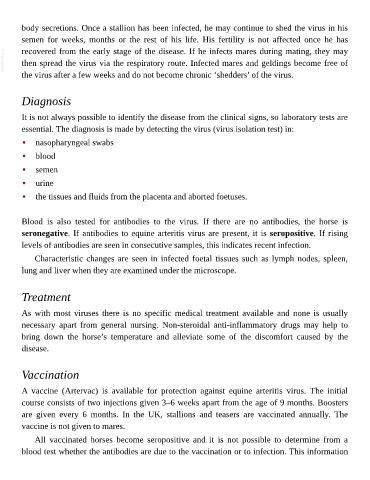Page 649 - The Veterinary Care of the Horse
P. 649
body secretions. Once a stallion has been infected, he may continue to shed the virus in his
semen for weeks, months or the rest of his life. His fertility is not affected once he has
VetBooks.ir recovered from the early stage of the disease. If he infects mares during mating, they may
then spread the virus via the respiratory route. Infected mares and geldings become free of
the virus after a few weeks and do not become chronic ‘shedders’ of the virus.
Diagnosis
It is not always possible to identify the disease from the clinical signs, so laboratory tests are
essential. The diagnosis is made by detecting the virus (virus isolation test) in:
• nasopharyngeal swabs
• blood
• semen
• urine
• the tissues and fluids from the placenta and aborted foetuses.
Blood is also tested for antibodies to the virus. If there are no antibodies, the horse is
seronegative. If antibodies to equine arteritis virus are present, it is seropositive. If rising
levels of antibodies are seen in consecutive samples, this indicates recent infection.
Characteristic changes are seen in infected foetal tissues such as lymph nodes, spleen,
lung and liver when they are examined under the microscope.
Treatment
As with most viruses there is no specific medical treatment available and none is usually
necessary apart from general nursing. Non-steroidal anti-inflammatory drugs may help to
bring down the horse’s temperature and alleviate some of the discomfort caused by the
disease.
Vaccination
A vaccine (Artervac) is available for protection against equine arteritis virus. The initial
course consists of two injections given 3–6 weeks apart from the age of 9 months. Boosters
are given every 6 months. In the UK, stallions and teasers are vaccinated annually. The
vaccine is not given to mares.
All vaccinated horses become seropositive and it is not possible to determine from a
blood test whether the antibodies are due to the vaccination or to infection. This information

